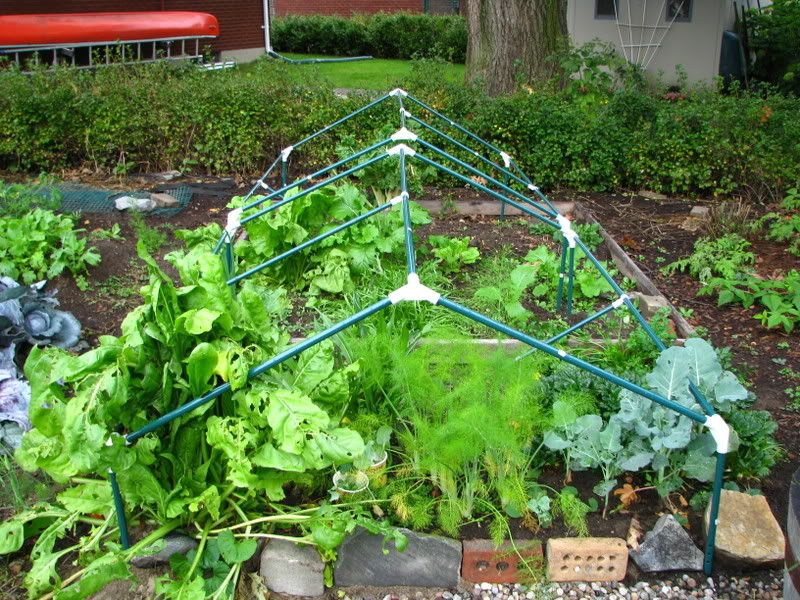
Fall crops overflowing the soon to be covered coldframe.
Growing Season - frost to frost?
Gardeners often describe their growing season as lasting from the last frost to the first frost but another way to look at it is from when the ground is workable until it is frozen in the fall. The frost to frost season in Ottawa is 4-5 months long but the workable season is around 7-8 months long. That's a heck of a lot more time to grow stuff. If you add some simple season extension devices like coldframes, tunnels, row covers and plastic mulch, you can add another month or two to that season bringing the possible amount of growing season in Ottawa to 9 months of the year!
Tomato - the gateway vegetable
When it comes to growing your own, tomatoes rank high in my list of gateway vegetables. As people often start their veggie patch on things like pumpkins, tomatoes and cucumbers, they make a habit of not planting or seeding until after the last spring frost date which in Ottawa happens sometime in mid-May (occasionally as late as early June and as early as late April). As the snow hangs around in Ottawa sometimes into April, it may mean that the ground isn't really diggable until the beginning of April anyhow so people just wait until the magic long May weekend to seed their carrots and lettuce as well.
By the time those tomatoes are killed off by the first frosts near the end of Sept, the lettuce has long gone to seed and those cabbage starts bought at a garden centre in those first warm spring days have been eaten up. The leaves fall and the season seems well and truly finished but it does not have to be that way.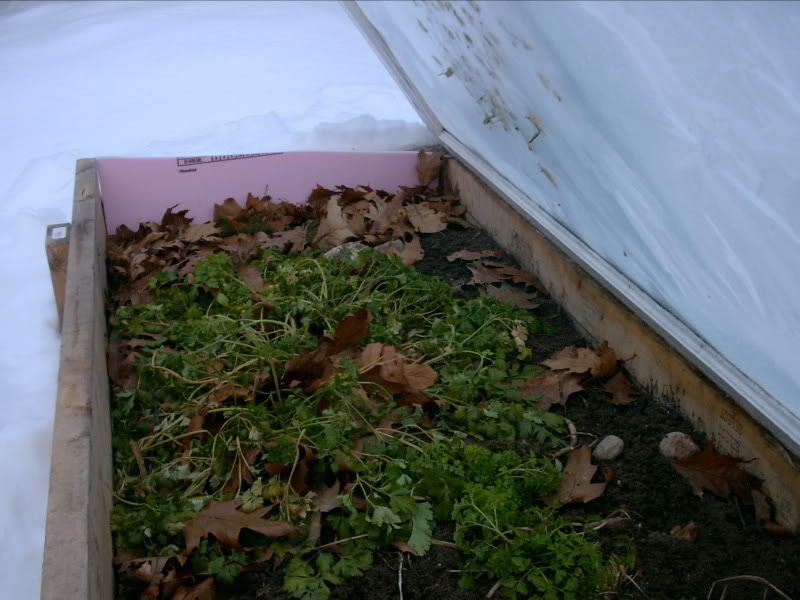
Coldframe with a healthy crop of parsley inside.
Some like it hot, many take it not
Members of the tomato family which such as potatoes, tomatillos, ground cherries etc... take no frost so transplants are placed out after the last frost date. Most vining crops such as pumpkins, squash, and beans are the same so they are also seeded when temperatures exceed 4C at night.
However, there are some vegetable families that will take it a lot cooler and these include most of the brassica family (mustards, cabbages, kale, rocket), spinach/goosefoot family (orach, spinach, swiss chard, beets), and the composite family (chop suey greens, chicory, lettuce). Many other root crops can be started a few weeks before last frost and several varities of legumes can be planted as soon as the ground is workable such as peas. The allium family has lots of examples of cool weather lovers from garlic, leeks to wild and perennial onions.
Cabbage started transplanted early with cutworm collars (those toilet paper rolls and cups) and pop bottles filled with water to help catch some heat for release at night (crossed fingers) to help moderate the temperatures. On really cold nights, I cover with a row cover or frost blanket.
Most good gardening books will have a calendar in the back which tells you when you place crops in the ground but here are some rules of thumb that I use.
- Peas and parsnips as soon as the ground can be worked
- Cool weather greens like spinach seeded under cover (coldframe and greenhouse) when soil is no longer frozen which can be as early as March 1
- Plants that can take it cold like broccoli or leeks but will bolt if exposed to temperatures that are too cold planted very early but under cover
- Fall gardens are planted mid-summer and include brussel sprouts, short season cabbage, kale, mustard, rocket, endive, lettuce, root crops, chicories like radicchio, mache, claytonia, florence fennel etc... I don't plant all of these out July 1 but plant according to how long it takes to mature a crop either outdoors or in a coldframe if that's where they are going. I also tend to start the cool weather loves in the light shade of a taller plant so that they are not exposed to full force of the summer sun. Some of the very fast baby leaf greens are started in August or even September.
- Some plants started way in the spring can be left in the ground until very hard frosts or heavy snow threatening such as long season cabbage, parsnips and celariac.
- I leave roots like carrots and jeruselum artichokes in the ground until frozen ground is on its way. You can also heavily mulch the ground over carrots, and beets etc... so that the ground is diggable later into the season. I use autumn leaves for mulch but eventually I bring in all my roots so I don't have to uncover them in the freezing cold outside. They are kept in a cellar under our stairs.
A list of cold hardy plants can be found in The Four Season Harvest by Coleman.
Polytunnel, Ottawa Gardener style - it will be changed into something all together different next year. Notice that it has a peaked roof. That's to prevent it flattening under our sometimes really heavy snow falls. A gothic roof is supposed to work too.
Under Cover
Some days it looks like I am growing plastic in the garden what with the polytunnel, cloches and row covers covering everything. I use coldframes and low tunnels to grow salad greens earlier and later into the season. A coldframe is a box of some sort made of wood or even straw bales with a top that is called a light and is made of any material that can let in sunlight such as an old storm window or plexiglass. My current coldframes are aluminum frames stretched with a kind of clear tent material. A low tunnel is nearly the same as a high tunnel except for - surprise surprise - the low one isn't as tall. They are both simple greenhouse structures that are made by stretching clear plastic (I use vapour barrier) over a frames - normally a hoop shape. Most years, I build a polytunnel / hoophouse / high tunnel overtop of my coldframes to increase the warmth inside. This is a technique I first read about in The Four Season Harvest by Coleman. Depending on your climate, you can just use a polytunnel to protect your winter crops from inclement weather and to increase the warmth for hot season crops like melons.
In the spring, I mulch the ground with clear plastic to warm the soil for some crops that are marginal for Ottawa including melons, and sweet potatoes (old blog). This also greatly improves the growth of peppers, eggplants and tomatoes as well. Ken Allan, from which I learned about this technique, also uses it for basil.
Black tire was covered with plastic to start melons (plastic mulch next picture).
As I often try to push the envelope and plant out my tomatoes in mid-May or even earlier, I put up a simple low tunnel frame around the bed so I can toss on some plastic if a late frost threatens.
I also use row covers to exclude insects and to improve growing conditions of early crops of leeks and brassicas like broccoli. A row cover is a light floating poly spun material. It can either be laid loosely ontop of the crop, with the edges secured or be laid over a frame. It will offer a couple degrees of frost protection. For cabbage, lettuce and sometimes vining crop transplants, I have used large water bottles, or just pop bottles, that people toss in two ways. With the bottoms cut out they make great cloches which are essentially mini coldframes and with filled with water and placed around plants or in the polytunnel the water inside gathers the day's heat and releases it at night. I have also used frost blankets (the kind used to wrap evergreens) to throw over my coldframes on extremely coldnights as insulation. Speaking of which, if you have solid insulation laying about, you can also put this over a coldframe when the mecury drops to ridiculously low levels.
Plastic mulched ground, low tunnel and bricks to catch heat.
A list of frost hardy plants that have worked for me
1. Mache / corn salad - amazing! It will last through the coldest weather in a coldframe and in mid-summer, it will reseed itself to start next winter's crop.
2. Claytonia
3. Beets and beet greens. I find these will last until the true winter cold hits but then the root starts to become mush.
4. Swiss chard - under double cover (coldframe plus high tunnel), this has survived extremely low temperatures.
5. Kale - dies back in the middle of winter but resprouts in the spring. In the garden, I have had several kinds overwinter under the snow.
6. Brussel Sprouts - survived and cropped under the high tunnel
7. Cabbage - I have never tried to overwinter a cabbage with a full head but those that have been cut and are reheading will survive under snow cover fairly well. In the polytunnel, I have had them do well until I pulled them mid-January.
8. Chinese cabbage will live until the really cold weather
9. Bok choy types grew well when seeded early in the coldframes
10. Tat soi types seem to take snow and freezing
11. Collards lasted most of last winter outside until the -20s with depleted snow cover.
12. Turnips - grow fast and crop well in the fall / early winter in coldframes but can't survive extreme cold.
13. Kholrabi - grew well but froze solid and was unusable in the height of winter. Can be seeded early in a coldframe.
14. Egyptian onion / green onions - do well in a polytunnel / high tunnel
15. Leek transplants survive extreme temperatures in my high tunnel as baby plants and later in the early spring garden under a row cover. I didn't have any bolting which sometimes happens when exposed to long periods of cold.
16. Broccoli - cropped a pop bottle cloche and coldframe while there was still some snow outside.
Pop bottle cloche.
17. Cabbage - does well if planted while still a threat of snow but ground is thawed under a pop bottle cloche.
18. Spinach - does very well seeded early in the coldframe or in the garden
19. Peas - can be started very early in the high tunnel or garden. I grow a late crop for pea shoots in the fall.
20. Carrots - about 3/4? overwinter if given half the chance. They are often useable once the ground has thawed in the spring.
21. Parsnips - cold hardy is their middle name
22. Chicory - Green leaf types seem to overwinter in my garden - I'll write more after some more experimentation ;-)
23. Lettuce - Can be seeded early in the coldframe but grows slower than spinach. Good to transplant with long season cabbage as they are harvested while the cabbage are still small.
24. Rocket - handles the cold.
25. Parsley - Only had to plant this once and it has maintained a very cold hardy troop in my garden ever since, reseeding itself.
26. Mizuna - In Ottawa this crop is ideal as it seems to take the modestly warm summers we get and extreme cold under the coldframes
27. Dandelions - If you enjoy these, they will survive quite nicely in the coldframe.
28. Minituna - related to plaintain - perennial, self seeding (I haven't seen that yet), cold hardy and good in salad. I also use it as a pot herb.
I'll add more as I think of it.
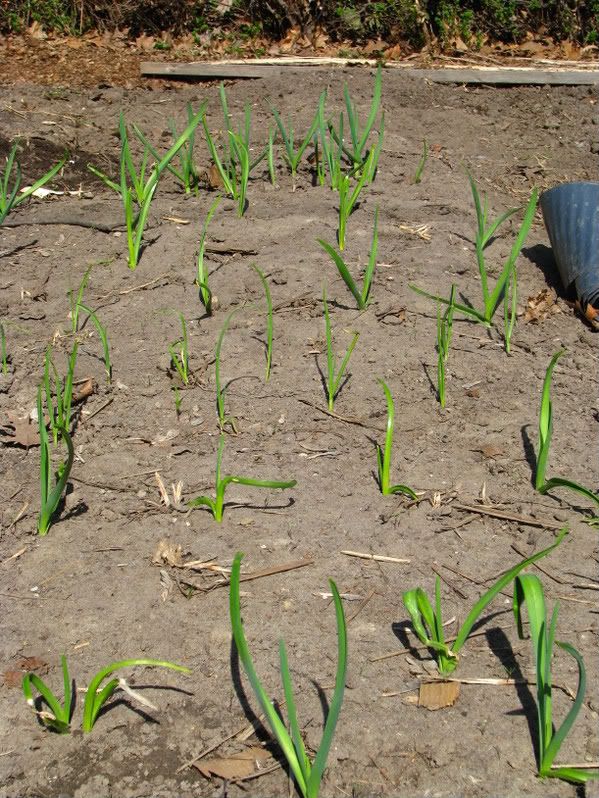 Fall planted garlic beats the weed competition by starting growing again very early in the spring. I replace this early.
Fall planted garlic beats the weed competition by starting growing again very early in the spring. I replace this early.

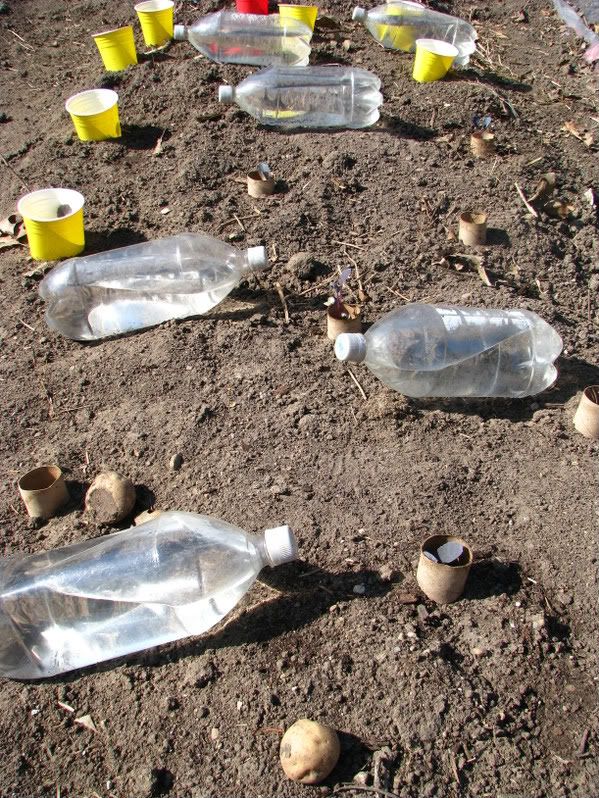
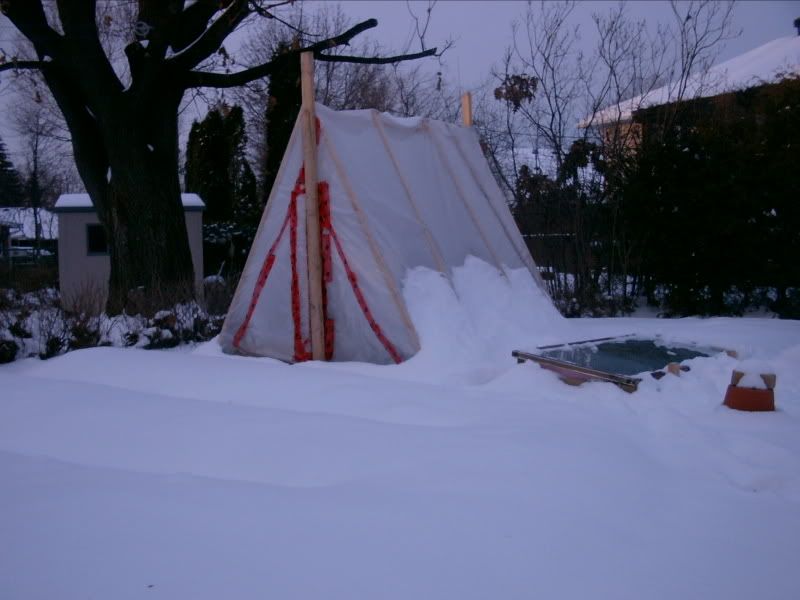

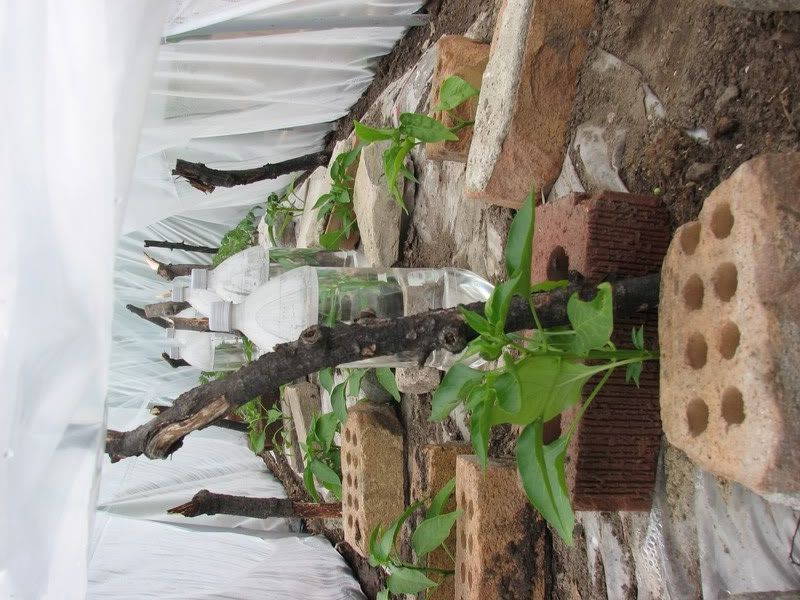
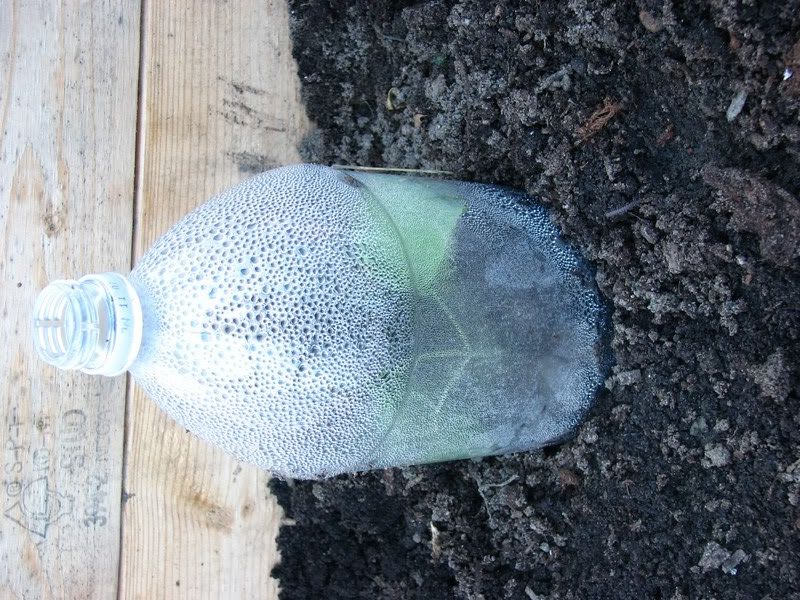
6 comments:
Hi there!
I'm really interested in this type of gardening and have taken your advice and bought the Four Season Gardener. Of course I'm too late to do anything this year and will be looking forward to setting something up in 2009. I do want to build a cold frame for my home garden, using an old shower door or some storm windows. All these cold-hardy vegetables are really intriguing. You've done a lot of research and experimenting!
BTW, let me know if you are still interested in vermicomposting. Mine are starting to become too productive!
Also, I'm a bum for not coming to pick up the Jerusalem and Chinese artichokes. Do they spread? And am I too late to put them in?
Wow, what a terrific post!
My ground hardly ever freezes, and if it does, it is usually only for a day or two, and not very deep. I wonder if it possible to garden all year here with heavily mulch soil and cold frames...
If your ground doesn't freeze and temps are normally above -10C then you could easily garden all year round if you choose the right crops. In many warm parts of Europe and somewhat in the west coast of Canada, the choice seems to be for a polytunnel or high tunnel without coldframes as it can do double duty increasing the heat in the summer for heat loving marginal crops. However, a coldframe will work very well too. As for mulching the ground, you could do that to prevent frost heaving around your root crops and to ensure that they remain diggable all winter.
Glad you enjoyed the post (I noted more than 1 typo... too busy to edit properly ;-)
Kathy: I am really interested in you doing this kind of gardening too! It's lots of fun to trudge through the snow, open your polytunnel and go 'hey it's warm in here' and 'OMG, the swiss chard is still alive. I'll have me some of that for dinner.' That's a great book. The 12 month gardener (available at the library) is pretty good too.
I am interested in vermicomposting. We could do a trade, worms for jeruselum artichokes. I dug some up earlier and they are in a pot outside my backdoor. They don't store well but if you have a patch of unfrozen ground (here it is up to 2C next monday) or are willing to pour warm water somewhere and dig a small trench, I'll give you some. Or, they'll be available next year in the spring.
The chinese artichokes won't be available again until the spring.
what an interesting post. i love the idea of using bricks and pop bottles to catch the heat. I'll have to check out the books mentioned in the comments. extending the growing season would be great...I threw in the towel at the end of october but maybe next year I can go a little longer.
irena
Tons of great information. Thanks.
Post a Comment